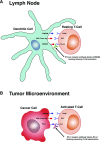Nephrotoxicity of Cancer Immunotherapies: Past, Present and Future
- PMID: 29959196
- PMCID: PMC6065079
- DOI: 10.1681/ASN.2018050488
Nephrotoxicity of Cancer Immunotherapies: Past, Present and Future
Abstract
Nephrotoxicity from cancer therapies is common and increasingly encountered in clinical practice, such that the subfield of "onco-nephrology" has emerged. Conventional chemotherapeutic drugs and novel agents targeting specific genes/proteins are effective cancer therapies but suffer from a number of adverse kidney effects. An effective avenue of cancer treatment is immunotherapy, which uses drugs that augment immune system-mediated recognition and targeting of tumor cells. As such, leveraging the immune system to target malignant cells represents an important modality in eradicating cancer. IFN and high-dose IL-2 are older immunotherapies used in clinical practice to treat various malignancies, whereas new cancer immunotherapies have emerged over the past decade that offer even more effective treatment options. The immune checkpoint inhibitors are an exciting addition to the cancer immunotherapy armamentarium. Chimeric antigen receptor T cells are also a new immunotherapy used to treat various hematologic malignancies. However, as with the conventional and targeted cancer agents, the immunotherapies are also associated with immune-related adverse effects, which includes nephrotoxicity.
Keywords: acute kidney injury; chimeric antigen receptor T-cells; immune checkpoint inhibitors; immunotherapies; interferon; interleukin-2.
Copyright © 2018 by the American Society of Nephrology.
Figures




Similar articles
-
Immunotherapy-Related Acute Kidney Injury.Adv Chronic Kidney Dis. 2021 Sep;28(5):429-437.e1. doi: 10.1053/j.ackd.2021.07.006. Adv Chronic Kidney Dis. 2021. PMID: 35190109 Review.
-
The nephrotoxicity of new immunotherapies.Expert Rev Clin Pharmacol. 2019 Jun;12(6):513-521. doi: 10.1080/17512433.2019.1613888. Epub 2019 May 8. Expert Rev Clin Pharmacol. 2019. PMID: 31035801 Review.
-
Next generation of immunotherapy for melanoma.J Clin Oncol. 2008 Jul 10;26(20):3445-55. doi: 10.1200/JCO.2007.14.6423. J Clin Oncol. 2008. PMID: 18612161 Review.
-
Acute Kidney Injury Associated with Novel Anticancer Therapies: Immunotherapy.Kidney360. 2025 Apr 1;6(4):652-662. doi: 10.34067/KID.0000000749. Epub 2025 Feb 24. Kidney360. 2025. PMID: 39992727 Free PMC article. Review.
-
Novel immunotherapies in GU malignancies.Curr Oncol Rep. 2013 Jun;15(3):224-31. doi: 10.1007/s11912-013-0306-8. Curr Oncol Rep. 2013. PMID: 23519772 Review.
Cited by
-
Risk factors associated with immune checkpoint inhibitor-induced acute kidney injury compared with other immune-related adverse events: a case-control study.Clin Kidney J. 2022 Apr 28;15(10):1881-1887. doi: 10.1093/ckj/sfac109. eCollection 2022 Oct. Clin Kidney J. 2022. PMID: 36158153 Free PMC article.
-
Incidence of death from kidney diseases among cancer patients: a US population-based analysis.Int Urol Nephrol. 2021 Dec;53(12):2627-2633. doi: 10.1007/s11255-021-02801-1. Epub 2021 Mar 8. Int Urol Nephrol. 2021. PMID: 33686534
-
Acute Interstitial Nephritis: A Rare and Unusual Side Effect of Omalizumab.J Investig Med High Impact Case Rep. 2020 Jan-Dec;8:2324709620946890. doi: 10.1177/2324709620946890. J Investig Med High Impact Case Rep. 2020. PMID: 32744093 Free PMC article.
-
Acute kidney injury from immune checkpoint inhibitor use.BMJ Case Rep. 2019 Oct 25;12(10):e231211. doi: 10.1136/bcr-2019-231211. BMJ Case Rep. 2019. PMID: 31653633 Free PMC article.
-
Immune checkpoint inhibitor related nephrotoxicity: Advances in clinicopathologic features, noninvasive approaches, and therapeutic strategy and rechallenge.Front Nephrol. 2022 Oct 19;2:1017921. doi: 10.3389/fneph.2022.1017921. eCollection 2022. Front Nephrol. 2022. PMID: 37674988 Free PMC article. Review.
References
-
- Rosner MH, Perazella MA: Acute kidney injury in patients with cancer. N Engl J Med 376: 1770–1781, 2017 - PubMed
-
- Porta C, Cosmai L, Gallieni M, Pedrazzoli P, Malberti F: Renal effects of targeted anticancer therapies. Nat Rev Nephrol 11: 354–370, 2015 - PubMed
-
- Schreiber RD, Old LJ, Smyth MJ: Cancer immunoediting: Integrating immunity’s roles in cancer suppression and promotion. Science 331: 1565–1570, 2011 - PubMed
-
- Hanahan D, Weinberg RA: Hallmarks of cancer: The next generation. Cell 144: 646–674, 2011 - PubMed
Publication types
MeSH terms
Substances
LinkOut - more resources
Full Text Sources
Other Literature Sources
Research Materials
Miscellaneous

